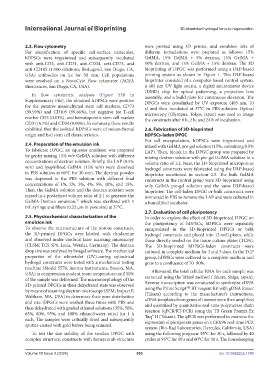Page 311 - IJB-10-3
P. 311
International Journal of Bioprinting 3D-bioprinted hydrogel for pulp regeneration
2.3. Flow cytometry were printed using 3D printer, and emulsion inks of
For identification of specific cell-surface molecules, different formulations were prepared as follows: 15%
hDPSCs were trypsinized and subsequently incubated GelMA, 15% GelMA + 5% dextran, 15% GelMA +
with anti-CD3, anti-CD31, anti-CD34, anti-CD73, and 10% dextran, and 15% GelMA + 15% dextran. The 3D
anti-CD105 (1:100 dilutions; BioLegend, San Diego, CA, bioprinting of DPGC was performed using a DLP-based
USA) antibodies on ice for 30 min. Cell populations printing system as shown in Figure 1. This DLP-based
were resolved on a NovoCyte Flow cytometer (ACEA bioprinter consisted of a computer-based control system,
Biosciences, San Diego, CA, USA). a 405 nm UV light source, a digital micromirror device
(DMD) chip for optical patterning, a projection lens
In flow cytometric analyses (Figure S3B in assembly, and a build plate for continuous elevation. The
Supplementary File), the obtained hDPSCs were positive DPGCs were crosslinked by UV exposure (405 nm, 10
for the putative mesenchymal stem cell markers, CD73 s) and then incubated at 37°C in PBS solution. Optical
(99.99%) and CD105 (99.86%), but negative for T-cell microscopy (Olympus, Tokyo, Japan) was used to image
marker CD3 (0.01%), and hematopoietic stem cell marker the constructs after 0 h, 2 h, and 24 h of incubation.
CD31 (8.7%) and CD34 (0.09%). In summary, these results
exhibited that the isolated hDPSCs were of mesenchymal 2.6. Fabrication of 3D-bioprinted
origin and had stem cell characteristics. hDPSCs-laden DPGC
For cell encapsulation, hDPSCs were trypsinized and
2.4. Preparation of the emulsion ink mixed with GelMA pre-gel solution (15%, containing 0.5%
To fabricate DPGC, an aqueous emulsion was prepared LAP). Then, bioink in the DPGC group was prepared by
by gently mixing 15% w/v GelMA solution with different mixing dextran solution with pre-gel GelMA solution in a
concentrations of dextran solution. Briefly, the LAP (0.5% volume ratio of 1:2. Next, the 3D-bioprinted microporous
w/v) and lyophilized GelMA (15% w/v) were dissolved hydrogel constructs were fabricated using the DLP-based
in PBS solution at 60°C for 30 min. The dextran powder bioprinter mentioned in section 2.5. The bulk GelMA
was dispersed in the PBS solution with different final constructs in the control group were 3D-bioprinted using
concentrations of 1%, 2%, 3%, 4%, 5%, 10%, and 15%. only GelMA pre-gel solution and the same DLP-based
Then, the GelMA solution and the dextran solution were bioprinter. The cell-laden DPGC or bulk constructs were
mixed in a predefined volume ratio of 2:1 to generate the immersed in PBS to remove the LAP and were cultured in
GelMA-Dextran emulsion, which was sterilized with 1 a humidified incubator.
25
mL syringe and filters (0.22 μm in pore size) at 37°C.
2.7. Evaluation of cell pluripotency
2.5. Physicochemical characterization of the In order to explore the effect of 3D-bioprinted DPGC on
emulsion ink the pluripotency of hDPSCs, hDPSCs were separately
To observe the microstructure of the porous constructs, encapsulated in the 3D-bioprinted DPGCs or bulk
the 3D-printed DPGCs were labeled with rhodamine hydrogel constructs and placed into 12-well plates, while
and observed under confocal laser scanning microscopy those directly seeded on the tissue culture plates (TCPs).
(CLSM; TCS SP8, Leica, Wetzlar, Germany). The dextran The 3D-bioprinted hDPSCs-laden constructs were
drop size was analyzed by ImageJ software. The mechanical cultured in complete medium for 3 and 5 days. In the TCP
properties of the ultraviolet (UV)-curing cylindrical group, hDPSCs were cultured in a complete medium and
hydrogel constructs were tested with a mechanical testing grew to a confluence of 70–80%.
machine (Model 5576, Instron Instruments, Boston, MA,
USA) in compression mode at room temperature until 50% Afterward, the total cellular RNA for each sample was
of the sample was deformed. The micromorphology of the extracted using the Trizol method (Takara, Shiga, Japan).
3D-printed DPGCs in their dehydrated state was observed Reverse transcription was conducted to synthesize cDNA
TM
by means of scanning electron microscopy (SEM; Inspect F, using the Prime Script RT reagent Kit with gDNA Eraser
Waltham, MA, USA) to determine their pore distribution (Takara) according to the manufacturer’s instructions.
cDNA templates from genes of interest were then amplified
and size. DPGCs were washed three times with PBS and and quantified by quantitative real-time polymerase chain
then dehydrated with graded ethanol solutions (35%, 50%, reaction (qPCR/RT-PCR) using the TB Green Premix Ex
65%, 80%, 95%, and 100% ethanol/water ratio) for 1 h Taq™ II (Takara). The qPCR was performed to examine the
each. The samples were critically dried and subsequently expression of pluripotent genes on a CFX96 real-time PCR
sputter-coated with gold before being scanned.
system (Bio-Rad Laboratories, Hercules, California, USA)
To test the size stability of the swollen DPGC with using the following program: 95°C for 30 s, followed by 40
complex structure, constructs with honeycomb structure cycles at 95°C for 10 s and 60°C for 30 s. The housekeeping
Volume 10 Issue 3 (2024) 303 doi: 10.36922/ijb.1790

